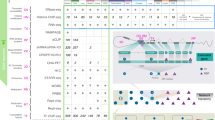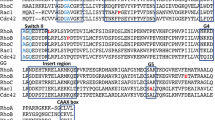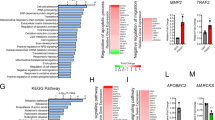Abstract
We have used microarray technology to identify the transcriptional targets of Rho subfamily guanosine 5′-triphosphate (GTP)ases in NIH3T3 cells. This analysis indicated that murine fibroblasts transformed by these proteins show similar transcriptomal profiles. Functional annotation of the regulated genes indicate that Rho subfamily GTPases target a wide spectrum of functions, although loci encoding proteins linked to proliferation and DNA synthesis/transcription are upregulated preferentially. Rho proteins promote four main networks of interacting proteins nucleated around E2F, c-Jun, c-Myc and p53. Of those, E2F, c-Jun and c-Myc are essential for the maintenance of cell transformation. Inhibition of Rock, one of the main Rho GTPase targets, leads to small changes in the transcriptome of Rho-transformed cells. Rock inhibition decreases c-myc gene expression without affecting the E2F and c-Jun pathways. Loss-of-function studies demonstrate that c-Myc is important for the blockage of cell-contact inhibition rather than for promoting the proliferation of Rho-transformed cells. However, c-Myc overexpression does not bypass the inhibition of cell transformation induced by Rock blockage, indicating that c-Myc is essential, but not sufficient, for Rock-dependent transformation. These results reveal the complexity of the genetic program orchestrated by the Rho subfamily and pinpoint protein networks that mediate different aspects of the malignant phenotype of Rho-transformed cells.
This is a preview of subscription content, access via your institution
Access options
Subscribe to this journal
Receive 50 print issues and online access
$259.00 per year
only $5.18 per issue
Buy this article
- Purchase on Springer Link
- Instant access to full article PDF
Prices may be subject to local taxes which are calculated during checkout







Similar content being viewed by others
Accession codes
References
Barsyte-Lovejoy D, Mao DY, Penn LZ . (2004). c-Myc represses the proximal promoters of GADD45a and GADD153 by a post-RNA polymerase II recruitment mechanism. Oncogene 23: 3481–3486.
Bolstad BM, Collin F, Simpson KM, Irizarry RA, Speed TP . (2004). Experimental design and low-level analysis of microarray data. Int Rev Neurobiol 60: 25–58.
Budzyn K, Marley PD, Sobey CG . (2006). Targeting Rho and Rho-kinase in the treatment of cardiovascular disease. Trends Pharmacol Sci 27: 97–104.
Calvano SE, Xiao W, Richards DR, Felciano RM, Baker HV, Cho RJ et al. (2005). A network-based analysis of systemic inflammation in humans. Nature 437: 1032–1037.
Chen C, Nussenzweig A, Guo M, Kim D, Li GC, Ling CC . (1996). Down-regulation of gadd153 by c-myc in rat fibroblasts and its effect on cell growth and radiation-induced apoptosis. Oncogene 13: 1659–1665.
Etienne-Manneville S, Hall A . (2002). Rho GTPases in cell biology. Nature 420: 629–635.
Gautier L, Cope L, Bolstad BM, Irizarry RA . (2004). affy–analysis of affymetrix genechip data at the probe level. Bioinformatics 20: 307–315.
Gentleman RC, Carey VJ, Bates DM, Bolstad B, Dettling M, Dudoit S et al. (2004). Bioconductor: open software development for computational biology and bioinformatics. Genome Biol 5: R80.
Hakem A, Sanchez-Sweatman O, You-Ten A, Duncan G, Wakeham A, Khokha R et al. (2005). RhoC is dispensable for embryogenesis and tumor initiation but essential for metastasis. Genes Dev 19: 1974–1979.
Hill CS, Wynne J, Treisman R . (1995). The Rho family GTPases RhoA, Rac1, and CDC42Hs regulate transcriptional activation by SRF. Cell 81: 1159–1170.
Jaffe AB, Hall A . (2005). Rho GTPases: biochemistry and biology. Annu Rev Cell Dev Biol 21: 247–269.
Leng X, Connell-Crowley L, Goodrich D, Harper JW . (1997). S-Phase entry upon ectopic expression of G1 cyclin-dependent kinases in the absence of retinoblastoma protein phosphorylation. Curr Biol 7: 709–712.
Liu AX, Rane N, Liu JP, Prendergast GC . (2001). RhoB is dispensable for mouse development, but it modifies susceptibility to tumor formation as well as cell adhesion and growth factor signaling in transformed cells. Mol Cell Biol 21: 6906–6912.
Marinissen MJ, Chiariello M, Tanos T, Bernard O, Narumiya S, Gutkind JS . (2004). The small GTP-binding protein RhoA regulates c-jun by a ROCK-JNK signaling axis. Mol Cell 14: 29–41.
Montaner S, Perona R, Saniger L, Lacal JC . (1998). Multiple signalling pathways lead to the activation of the nuclear factor kappaB by the Rho family of GTPases. J Biol Chem 273: 12779–12785.
Montaner S, Perona R, Saniger L, Lacal JC . (1999). Activation of serum response factor by RhoA is mediated by the nuclear factor-kappaB and C/EBP transcription factors. J Biol Chem 274: 8506–8515.
Parrish RS, Spencer III HJ . (2004). Effect of normalization on significance testing for oligonucleotide microarrays. J Biopharm Stat 14: 575–589.
Perona R, Montaner S, Saniger L, Sanchez-Perez I, Bravo R, Lacal JC . (1997). Activation of the nuclear factor-kappaB by Rho, CDC42, and Rac-1 proteins. Genes Dev 11: 463–475.
Riento K, Ridley AJ . (2003). Rocks: multifunctional kinases in cell behaviour. Nat Rev Cell Biol 4: 446–456.
Sahai E, Ishizaki T, Narumiya S, Treisman R . (1999). Transformation mediated by RhoA requires activity of ROCK kinases. Curr Biol 9: 136–145.
Schuebel KE, Movilla N, Rosa JL, Bustelo XR . (1998). Phosphorylation-dependent and constitutive activation of Rho proteins by wild-type and oncogenic Vav-2. EMBO J 17: 6608–6621.
Simpson KJ, Dugan AS, Mercurio AM . (2004). Functional analysis of the contribution of RhoA and RhoC GTPases to invasive breast carcinoma. Cancer Res 64: 8694–8701.
Teramoto H, Malek RL, Behbahani B, Castellone MD, Lee NH, Gutkind JS . (2003). Identification of H-Ras, RhoA, Rac1 and Cdc42 responsive genes. Oncogene 22: 2689–2697.
Uehata M, Ishizaki T, Satoh H, Ono T, Kawahara T, Morishita T et al. (1997). Calcium sensitization of smooth muscle mediated by a Rho-associated protein kinase in hypertension. Nature 389: 990–994.
van der Eb AJ, Graham FL . (1980). Assay of transforming activity of tumor virus DNA. Methods Enzymol 65: 826–839.
Watnick RS, Cheng YN, Rangarajan A, Ince TA, Weinberg RA . (2003). Ras modulates Myc activity to repress thrombospondin-1 expression and increase tumor angiogenesis. Cancer Cell 3: 219–231.
Wheeler AP, Ridley AJ . (2004). Why three Rho proteins? RhoA, RhoB, RhoC, and cell motility. Exp Cell Res 301: 43–49.
Wu M, Wu ZF, Kumar-Sinha C, Chinnaiyan A, Merajver SD . (2004). RhoC induces differential expression of genes involved in invasion and metastasis in MCF10A breast cells. Breast Cancer Res Treat 84: 3–12.
Acknowledgements
This work was supported by grants from the Ramón Areces Foundation, the NCI/NIH (5RO1-CA73735-10) and the Spanish Ministry of Education and Science Special Action on Genomics and Proteomics (GEN2003-20239-C06-01). IMB was supported by a Spanish Ministry of Education and Science FPU fellowship (FP2000-6489). FN was partially supported by a Ernst Schering Foundation fellowship. The genomic data of this work are deposited in the NCBI Gene Expression Omnibus database (Accession number: GSE5913).
Author information
Authors and Affiliations
Corresponding author
Additional information
Supplementary Information accompanies the paper on the Oncogene website (http://www.nature.com/onc).
Supplementary information
Rights and permissions
About this article
Cite this article
Berenjeno, I., Núñez, F. & Bustelo, X. Transcriptomal profiling of the cellular transformation induced by Rho subfamily GTPases. Oncogene 26, 4295–4305 (2007). https://doi.org/10.1038/sj.onc.1210194
Received:
Revised:
Accepted:
Published:
Issue Date:
DOI: https://doi.org/10.1038/sj.onc.1210194
Keywords
This article is cited by
-
C3 exoenzyme impairs cell proliferation and apoptosis by altering the activity of transcription factors
Naunyn-Schmiedeberg's Archives of Pharmacology (2016)
-
OTUB1 de-ubiquitinating enzyme promotes prostate cancer cell invasion in vitro and tumorigenesis in vivo
Molecular Cancer (2015)
-
Chd2 interacts with H3.3 to determine myogenic cell fate
The EMBO Journal (2012)
-
Expression of VAV1 in the tumour microenvironment of glioblastoma multiforme
Journal of Neuro-Oncology (2012)
-
Inhibition of Tumor Cell Migration and Invasion Through Knockdown of Rac1 Expression in Medulloblastoma Cells
Cellular and Molecular Neurobiology (2011)



